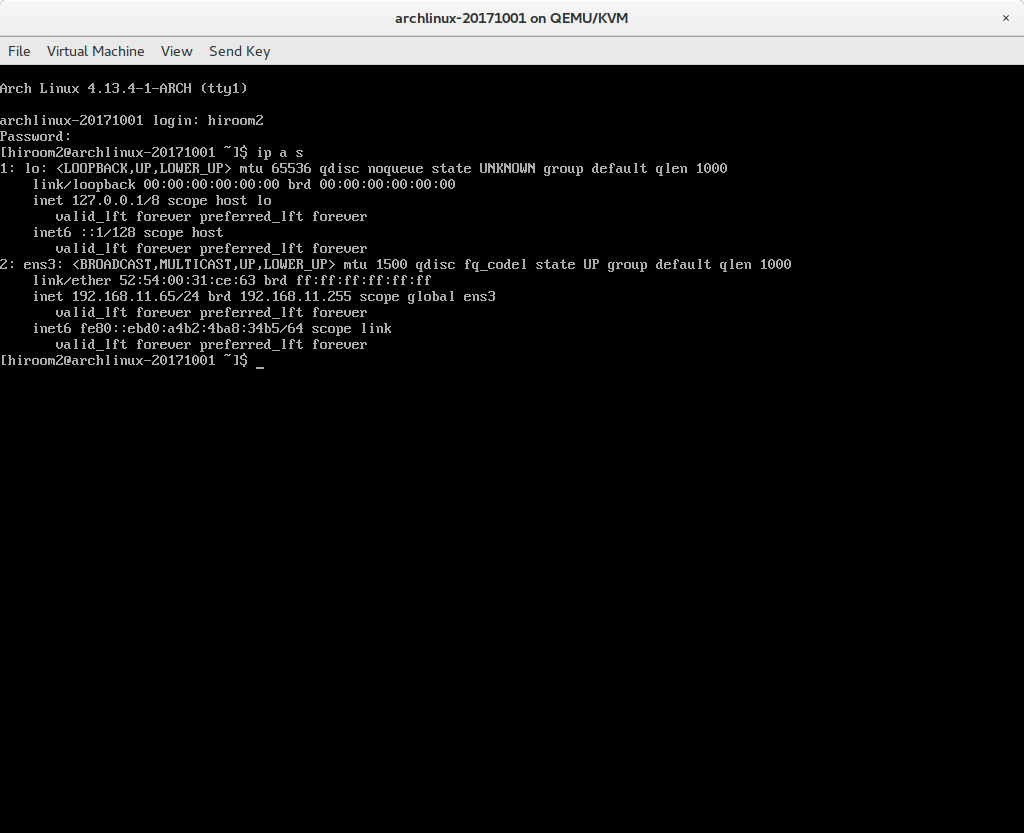This article will describe installing ArchLinux.
Table of Contents
1 Download LiveDVD
Download archlinux-2017.10.01-x86_64.iso from ArchLinux download page.
2 Run LiveDVD
LiveDVD will display the following menu. Press ENTER key at "Boot Arch Linux (x86_64)".

Automatically login as root user.
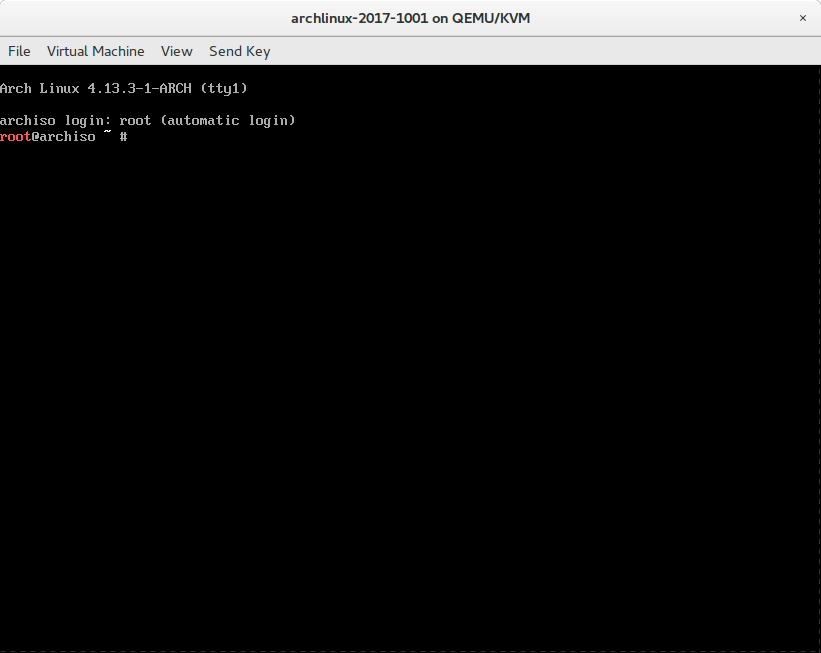
2.1 Serial console
You can use copy and paste on serial console. Because the bootloader in install media supports serial console, connecting to serial console outputs bootloader menu.
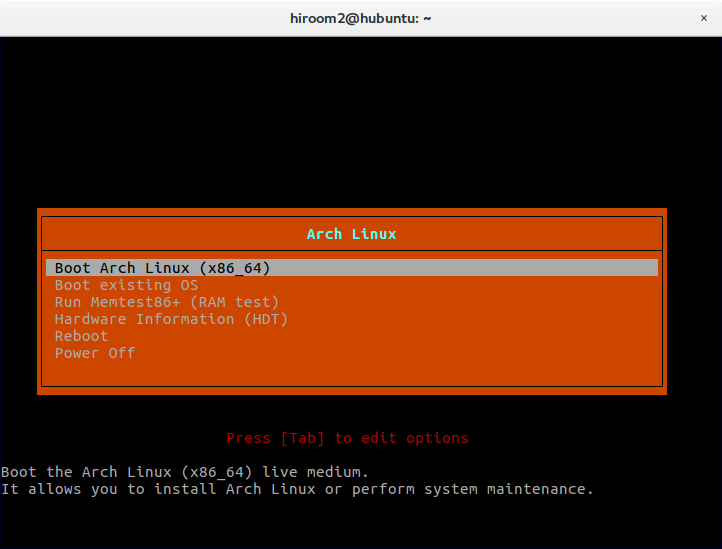
Press TAB key and append "console=ttyS0,115200" to kernel parameter. And then press ENTER key.
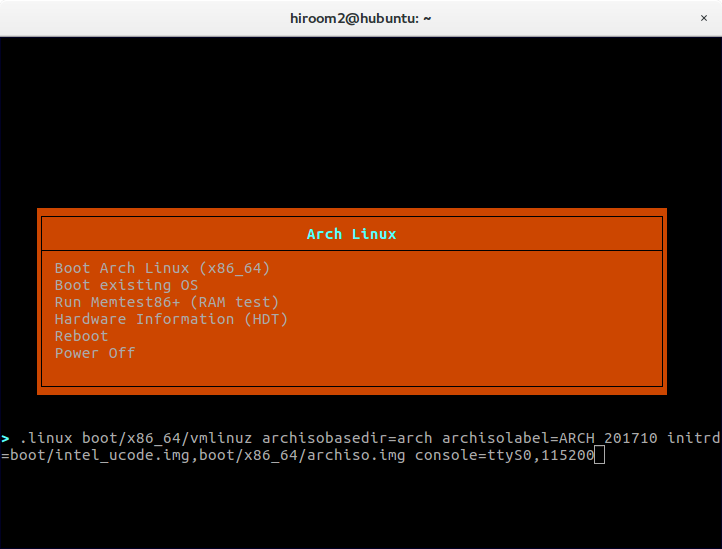
You can login with root user without password.
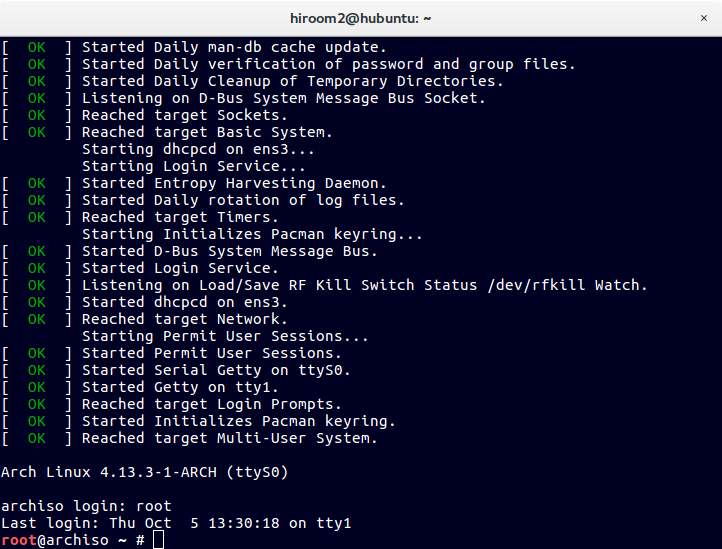
3 Configuration with LiveDVD
This section will describe a configuration on LiveDVD before arch-chroot.
3.1 Disk partitions
/proc/partions before running fdisk are as the following. Change /dev/vda to your block device like /dev/sda.
root@archiso ~ # cat /proc/partitions major minor #blocks name 254 0 10485760 vda 11 0 535552 sr0 7 0 417876 loop0
Run fdisk to /dev/vda.
root@archiso ~ # fdisk /dev/vda Welcome to fdisk (util-linux 2.30.2). Changes will remain in memory only, until you decide to write them. Be careful before using the write command. Device does not contain a recognized partition table. Created a new DOS disklabel with disk identifier 0xae297af2. Command (m for help):
Create a partion for /boot which size is 256MByte.
Command (m for help): n
Partition type
p primary (0 primary, 0 extended, 4 free)
e extended (container for logical partitions)
Select (default p): p
Partition number (1-4, default 1): 1
First sector (2048-20971519, default 2048): 2048
Last sector, +sectors or +size{K,M,G,T,P} (2048-20971519, default 20971519): +256M
Created a new partition 1 of type 'Linux' and of size 256 MiB.
Create a partion for LVM which uses rest of size.
Command (m for help): n
Partition type
p primary (1 primary, 0 extended, 3 free)
e extended (container for logical partitions)
Select (default p): p
Partition number (2-4, default 2): 2
First sector (526336-20971519, default 526336): 526336
Last sector, +sectors or +size{K,M,G,T,P} (526336-20971519, default 20971519):
Created a new partition 2 of type 'Linux' and of size 9.8 GiB.
Append boot label to /boot partion.
Command (m for help): a Partition number (1,2, default 2): 1 The bootable flag on partition 1 is enabled now.
Change label of LVM partition to "Linux LVM".
Command (m for help): t Partition number (1,2, default 2): 2 Partition type (type L to list all types): 8e Changed type of partition 'Linux' to 'Linux LVM'.
Update partitions.
Command (m for help): w The partition table has been altered. Calling ioctl() to re-read partition table. Syncing disks.
The partions after running fdisk are as below.
root@archiso ~ # fdisk -l /dev/vda Disk /dev/vda: 10 GiB, 10737418240 bytes, 20971520 sectors Units: sectors of 1 * 512 = 512 bytes Sector size (logical/physical): 512 bytes / 512 bytes I/O size (minimum/optimal): 512 bytes / 512 bytes Disklabel type: dos Disk identifier: 0x7f1f7d19 Device Boot Start End Sectors Size Id Type /dev/vda1 * 2048 526335 524288 256M 83 Linux /dev/vda2 526336 20971519 20445184 9.8G 8e Linux LVM
3.2 LVM
Create physical volue on /dev/vda2.
root@archiso ~ # pvcreate /dev/vda2 Physical volume "/dev/vda2" successfully created.
Create volume group which names vg_archlinux with /dev/vda2.
root@archiso ~ # vgcreate vg_archlinux /dev/vda2 Volume group "vg_archlinux" successfully created
Create logical volume which names lv_swap from vg_archlinux.
root@archiso ~ # lvcreate -L 1G -n lv_swap vg_archlinux Logical volume "lv_swap" created.
Create logical volume which names lv_root from vg_archlinux.
root@archiso ~ # lvcreate -l 100%FREE -n lv_root vg_archlinux Logical volume "lv_root" created.
The logical volumes are as below.
root@archiso ~ # lvdisplay --- Logical volume --- LV Path /dev/vg_archlinux/lv_swap LV Name lv_swap VG Name vg_archlinux LV UUID ooRdRU-Z1sm-3oZZ-lWK5-ntE3-2bAp-Vcgf6V LV Write Access read/write LV Creation host, time archiso, 2017-10-06 06:25:12 +0000 LV Status available # open 0 LV Size 1.00 GiB Current LE 256 Segments 1 Allocation inherit Read ahead sectors auto - currently set to 256 Block device 253:0 --- Logical volume --- LV Path /dev/vg_archlinux/lv_root LV Name lv_root VG Name vg_archlinux LV UUID yvvRsQ-3ELb-yIdd-kLbC-8hlQ-gdXE-HVpU4D LV Write Access read/write LV Creation host, time archiso, 2017-10-06 06:25:34 +0000 LV Status available # open 0 LV Size <8.75 GiB Current LE 2239 Segments 1 Allocation inherit Read ahead sectors auto - currently set to 256 Block device 253:1
3.3 Filesystem
Format /dev/vda1 with ext4.
root@archiso ~ # mkfs.ext4 /dev/vda1
mke2fs 1.43.6 (29-Aug-2017)
Creating filesystem with 262144 1k blocks and 65536 inodes
Filesystem UUID: 1ae02bc4-24eb-4b0f-b2e5-53f3a295cdfa
Superblock backups stored on blocks:
8193, 24577, 40961, 57345, 73729, 204801, 221185
Allocating group tables: done
Writing inode tables: done
Creating journal (8192 blocks): done
Writing superblocks and filesystem accounting information: done
Format /dev/vg_archlinux/lv_root with ext4.
root@archiso ~ # mkfs.ext4 /dev/vg_archlinux/lv_root
mke2fs 1.43.6 (29-Aug-2017)
Creating filesystem with 2292736 4k blocks and 573440 inodes
Filesystem UUID: eb0a11e4-463d-4bec-8fe5-89b856eeec1b
Superblock backups stored on blocks:
32768, 98304, 163840, 229376, 294912, 819200, 884736, 1605632
Allocating group tables: done
Writing inode tables: done
Creating journal (16384 blocks): done
Writing superblocks and filesystem accounting information: done
Create swap on /dev/vg_archlinux/lv_swap.
root@archiso ~ # mkswap /dev/vg_archlinux/lv_swap Setting up swapspace version 1, size = 1024 MiB (1073737728 bytes) no label, UUID=81080828-7edb-4b95-8d88-4ed4d2ee736f
Mount filesystems to /mnt and enable swap.
root@archiso ~ # mount -t ext4 /dev/vg_archlinux/lv_root /mnt root@archiso ~ # mkdir /mnt/boot root@archiso ~ # mount -t ext4 /dev/vda1 /mnt/boot root@archiso ~ # swapon /dev/vg_archlinux/lv_swap
3.4 Install packages
Install base, sudo, grub, lvm2 and openssh with pacstrap.
root@archiso ~ # pacstrap /mnt base sudo grub lvm2 openssh ==> Creating install root at /mnt ==> Installing packages to /mnt :: Synchronizing package databases...
A detail of package group is here.
3.5 Create fstab
Create /etc/fstab with genfstab.
root@archiso ~ # genfstab -p /mnt > /mnt/etc/fstab root@archiso ~ # cat /mnt/etc/fstab # UUID=eb0a11e4-463d-4bec-8fe5-89b856eeec1b /dev/mapper/vg_archlinux-lv_root / ext4 rw,relatime,data=ordered 0 1 # UUID=1ae02bc4-24eb-4b0f-b2e5-53f3a295cdfa /dev/vda1 /boot ext4 rw,relatime,data=ordered 0 2 # UUID=81080828-7edb-4b95-8d88-4ed4d2ee736f /dev/mapper/vg_archlinux-lv_swap none swap defaults 0 0
4 Configuration with arch-chroot
Change root to /mnt with arch-chroot.
root@archiso ~ # arch-chroot /mnt [root@archiso /]#
4.1 Enable service
Enable dhcpcd.service and sshd.service. dhcpcd.service is a service for DHCP client.
[root@archiso /]# ln -s /usr/lib/systemd/system/dhcpcd.service \ /etc/systemd/system/multi-user.target.wants/dhcpcd.service [root@archiso /]# ln -s /usr/lib/systemd/system/sshd.service \ /etc/systemd/system/multi-user.target.wants/sshd.service
4.2 Set hostname
Set hostname to /etc/hostname.
[root@archiso /]# echo archlinux-20171001 > /etc/hostname
4.3 Create locale
Create /etc/locale.gen and /etc/locale.conf. This article uses en_US.UTF-8.
[root@archiso /]# sed -e 's/^#en_US.UTF-8 UTF-8/en_US.UTF-8 UTF-8/g' \ -i /etc/locale.gen [root@archiso /]# locale-gen Generating locales... en_US.UTF-8... done Generation complete. [root@archiso /]# echo "LANG=en_US.UTF-8" > /etc/locale.conf
4.4 Set root password
Set root password.
[root@archiso /]# passwd Enter new UNIX password: Retype new UNIX password: passwd: password updated successfully
4.5 Enable sudo
Remove comment before %wheel.
[root@archiso /]# sed -i /etc/sudoers \ -e 's/^# %wheel ALL=(ALL) NOPASSWD: ALL/%wheel ALL=(ALL) NOPASSWD: ALL/g'
4.6 Create user
Create user.
[root@archiso /]# useradd -m hiroom2
Set user password.
[root@archiso /]# passwd hiroom2 Enter new UNIX password: Retype new UNIX password: passwd: password updated successfully
Add user to wheel group which can use sudo.
[root@archiso /]# gpasswd -a hiroom2 wheel Adding user hiroom2 to group wheel
4.7 Create initramfs
Add a lvm2 script to initramfs.
[root@archiso /]# sed -e 's/^HOOKS="\(.*\)"/HOOKS="\1 lvm2"/g' \ -i /etc/mkinitcpio.conf
Create initramfs with mkinitcpio.
[root@archiso /]# mkinitcpio -p linux ==> Building image from preset: /etc/mkinitcpio.d/linux.preset: 'default' -> -k /boot/vmlinuz-linux -c /etc/mkinitcpio.conf -g /boot/initramfs-linux.img ==> Starting build: 4.13.3-1-ARCH -> Running build hook: [base] -> Running build hook: [udev] -> Running build hook: [autodetect] -> Running build hook: [modconf] -> Running build hook: [block] -> Running build hook: [filesystems] -> Running build hook: [keyboard] -> Running build hook: [fsck] -> Running build hook: [lvm2] ==> Generating module dependencies ==> Creating gzip-compressed initcpio image: /boot/initramfs-linux.img ==> Image generation successful ==> Building image from preset: /etc/mkinitcpio.d/linux.preset: 'fallback' -> -k /boot/vmlinuz-linux -c /etc/mkinitcpio.conf -g /boot/initramfs-linux-fallback.img -S autodetect ==> Starting build: 4.13.3-1-ARCH -> Running build hook: [base] -> Running build hook: [udev] -> Running build hook: [modconf] -> Running build hook: [block] ==> WARNING: Possibly missing firmware for module: aic94xx ==> WARNING: Possibly missing firmware for module: wd719x -> Running build hook: [filesystems] -> Running build hook: [keyboard] -> Running build hook: [fsck] -> Running build hook: [lvm2] ==> Generating module dependencies ==> Creating gzip-compressed initcpio image: /boot/initramfs-linux-fallback.img ==> Image generation successful
4.8 Install GRUB
Change "root=UUID=xxx" of kernel parameter to "root=/dev/xxx".
[root@archiso /]# sed -i /etc/default/grub \ -e 's/^#GRUB_DISABLE_LINUX_UUID=true/GRUB_DISABLE_LINUX_UUID=true/g'
Install GRUB to /boot and MBR of /dev/vda.
[root@archiso /]# grub-install --boot-directory=/boot /dev/vda Installing for i386-pc platform. Installation finished. No error reported.
Update grub.cfg.
[root@archiso /]# grub-mkconfig -o /boot/grub/grub.cfg Generating grub configuration file ... WARNING: Failed to connect to lvmetad. Falling back to device scanning. WARNING: Failed to connect to lvmetad. Falling back to device scanning. WARNING: Failed to connect to lvmetad. Falling back to device scanning. WARNING: Failed to connect to lvmetad. Falling back to device scanning. WARNING: Failed to connect to lvmetad. Falling back to device scanning. WARNING: Failed to connect to lvmetad. Falling back to device scanning. WARNING: Failed to connect to lvmetad. Falling back to device scanning. WARNING: Failed to connect to lvmetad. Falling back to device scanning. WARNING: Failed to connect to lvmetad. Falling back to device scanning. WARNING: Failed to connect to lvmetad. Falling back to device scanning. Found linux image: /boot/vmlinuz-linux Found initrd image(s) in /boot: initramfs-linux.img Found fallback initrd image(s) in /boot: initramfs-linux-fallback.img done
Reboot system and boot ArchLinux from /dev/vda.
sh-4.3# exit root@archiso ~ # umount /mnt/boot root@archiso ~ # umount /mnt root@archiso ~ # reboot
5 Run ArchLinux
GRUB in /dev/vda starts.

Login prompt is displayed. If DHCP server is running in your network, IP address is assigned with dhcpcd.
